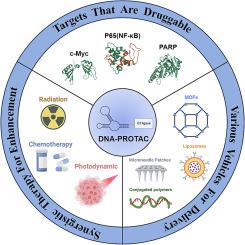基于dna的蛋白水解靶向嵌合体技术的进展:靶向癌症治疗中先前不可药物蛋白的新策略
IF 3
3区 医学
Q2 BIOCHEMISTRY & MOLECULAR BIOLOGY
引用次数: 0
摘要
靶向蛋白降解(TPD)技术已经成为一种变革性的治疗策略,可以选择性地消除不同病理条件下的异常蛋白。本文系统地综述了基于DNA的靶向蛋白水解嵌合体(DNA-PROTACs)的最新进展,它利用DNA的特殊特异性和结合亲和力,大大扩展了传统小分子PROTACs之外的靶向蛋白库。通过广泛的文献分析,包括机制研究、临床前评估和临床调查,我们证明了DNA- protacs有效地靶向以前无法治疗的蛋白质,包括转录因子、细胞膜蛋白和DNA损伤反应介质。这些创新的嵌合结构通过蛋白酶体降解途径通过E3泛素连接酶的招募表现出卓越的催化效率,在DNA合成过程中通过精确的核苷酸水平控制实现连接优化方面具有独特的优势。与传统的PROTAC方式和其他基于rna的方法相比,基于细胞的检测始终显示出更高的选择性和更大的治疗窗口。尽管有很好的临床前结果和提前的临床开发时间表,但在递送优化、分子稳定性增强和临床转化方面的挑战仍然存在。人工智能辅助药物设计平台和体内适体进化技术的整合为加速DNA-PROTACs向亚纳摩尔效力靶点的发展提供了前所未有的机会,将该技术定位为肿瘤学,免疫治疗和神经退行性疾病治疗的精准医学范式转变方法。本文章由计算机程序翻译,如有差异,请以英文原文为准。

Advances in DNA-based proteolysis-targeting chimeras technology: Novel strategies for targeting previously undruggable proteins in cancer therapy
Targeted protein degradation (TPD) technology has emerged as a transformative therapeutic strategy for selectively eliminating aberrant proteins across diverse pathological conditions. This comprehensive review systematically examines recent advances in DNA-based proteolysis-targeting chimeras (DNA-PROTACs), which harness the exceptional specificity and binding affinity of DNA to substantially expand the targetable protein repertoire beyond conventional small molecule PROTACs. Through extensive literature analysis encompassing mechanistic studies, preclinical evaluations, and clinical investigations, we demonstrate that DNA-PROTACs effectively target previously undruggable proteins, including transcription factors, cell membrane proteins, and DNA damage response mediators. These innovative chimeric constructs exhibit superior catalytic efficiency through E3 ubiquitin ligase recruitment via the proteasomal degradation pathway, with unique advantages in linker optimization enabled by precise nucleotide-level control during DNA synthesis. Cell-based assays consistently reveal enhanced selectivity profiles and expanded therapeutic windows compared to traditional PROTAC modalities and alternative RNA-based approaches. Despite promising preclinical outcomes and advancing clinical development timelines, challenges in delivery optimization, molecular stability enhancement, and clinical translation persist. The integration of artificial intelligence-assisted drug design platforms and in vivo aptamer evolution technologies presents unprecedented opportunities for accelerating DNA-PROTACs development toward sub-nanomolar potency targets, positioning this technology as a paradigm-shifting approach in precision medicine across oncology, immunotherapy, and neurodegeneration therapeutics.
求助全文
通过发布文献求助,成功后即可免费获取论文全文。
去求助
来源期刊

Bioorganic & Medicinal Chemistry
医学-生化与分子生物学
CiteScore
6.80
自引率
2.90%
发文量
413
审稿时长
17 days
期刊介绍:
Bioorganic & Medicinal Chemistry provides an international forum for the publication of full original research papers and critical reviews on molecular interactions in key biological targets such as receptors, channels, enzymes, nucleotides, lipids and saccharides.
The aim of the journal is to promote a better understanding at the molecular level of life processes, and living organisms, as well as the interaction of these with chemical agents. A special feature will be that colour illustrations will be reproduced at no charge to the author, provided that the Editor agrees that colour is essential to the information content of the illustration in question.
 求助内容:
求助内容: 应助结果提醒方式:
应助结果提醒方式:


